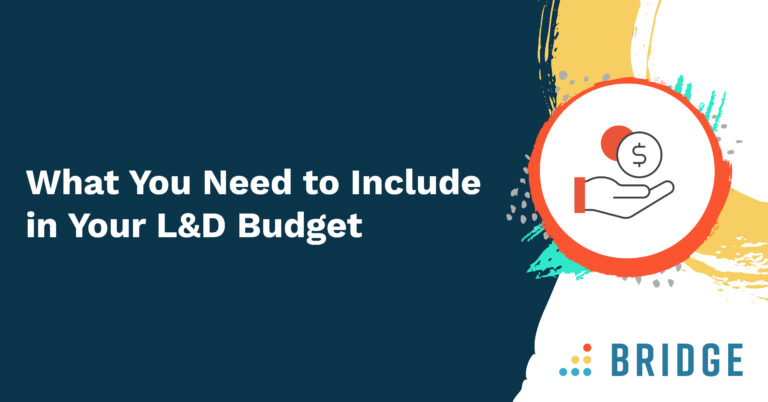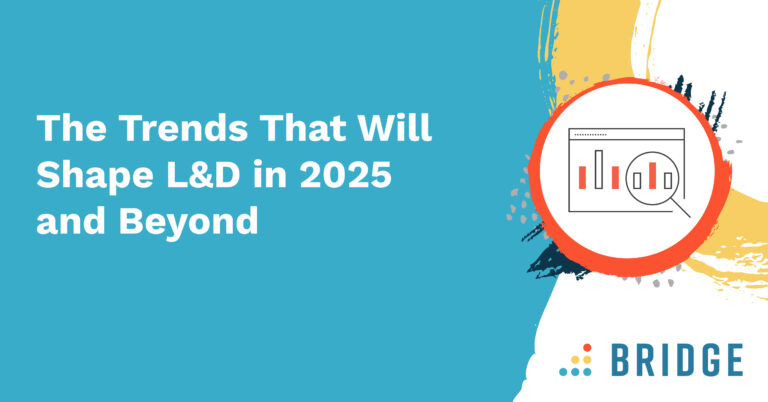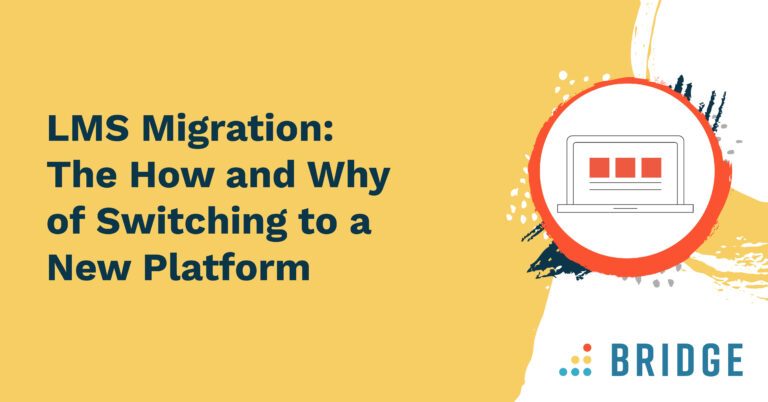You know better than anyone else that learning and development is an asset to your business. For your business leaders to recognize this value, it’s important to position L&D as an investment and show that the dollars you spend translate into positive business results.
If you’re wondering how, this article looks at what you should consider when building an L&D budget and how to demonstrate the business impact of your training programs.
Connecting the Dots Between L&D and Business Goals
Knowing what your team spends and the return on investment of your efforts is key. Put simply, your C-Suite execs want tangible metrics.
Although 77% of leaders say that upskilling is a priority for their organization, 60% of HR professionals feel that budget constraints prevent them from taking action. That’s according to the Bridge-sponsored “Future of Upskilling and Employee Learning 2024” report. In practice, this means you must make a strong case for learning and development.
So, what’s the solution? Further findings show that businesses need to see the impact of learning and development presented in a way that stakeholders across the business can recognize. As such, survey respondents who say L&D is an organizational priority are more likely to capture and use an array of metrics to share the value of their strategies. These include:
- Return on investment
- Employee productivity
- Talent mobility
- Skills assessments
Presenting a clear budget that outlines how your strategy will solve current challenges shows the value and signals to your organization that your team is closely aligned with its goals.
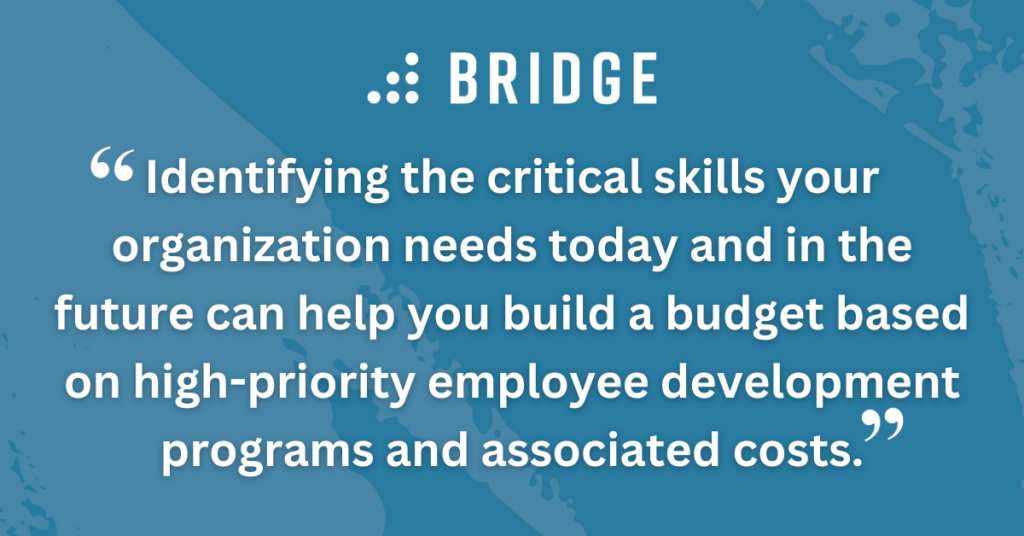
How to Build an L&D Budget
Allocating your L&D budget requires careful planning and foresight to predict and adapt to current and future objectives. There are several approaches you can take to account for these needs.
Analyze Past Performance and Spending
Review your budget over recent years, the items included, and the number of employees each year. These figures will give you a cost per employee for each year and show you any underlying trends. With this information, you can predict any near-future costs you might expect to incur.
Benchmark Based on Industry Standards
Looking at average spending data in your market or industry can give you insight into what other teams are spending and where they're using their budget. This method is helpful if your information has gaps or if you need to provide evidence that supports your investment.
Anticipate Future Skills Needs
Identifying the critical skills your organization needs today and in the future can help you build a budget based on high-priority employee development programs and associated costs. Focus on the upskilling and reskilling initiatives to close current and anticipated skills gaps and allocate spending based on the areas that will keep your organization competitive.
Evaluate Your Organization’s Objectives
Your organization has specific goals, and your budget must reflect them. Prioritizing budget spending based on the anticipated business impact shows your execs that investing in L&D will drive results through employee performance.
ADDITIONAL INSIGHTS | ‘Pitch (And Implement) Your Training Budget With These 4 Simple Steps’
Key Costs to Factor Into Your L&D Budget
List the items in your budget, including an estimated cost or existing spending for items you currently use.
For example, account for essential items such as:
- Ongoing subscription fees for an LMS
- One-time purchase and setup fees
- Third-party learning content
- Expenses associated with in-person training
- External trainers and SMEs
How to Get Buy-In for Your L&D Budget
Focus on how these resources will positively impact performance per your organization's strategic priorities. Below are some examples to help you communicate the value.
Highlight the Potential Risks of Noncompliance
Although the compliance risks might be different for each organization, the reasons to comply are the same. Completing mandatory training keeps your business and customers safe and protects you from any legal or financial penalties.
For instance, data compiled in an ebook by Bridge and its sister companies found that in 2023, the US Securities and Exchange Commission reported fines for financial noncompliance totaling around $5 billion. That's where an LMS comes in.
To make your business case, connect your organization's specific compliance requirements to the financial penalties for noncompliance. For instance, using a learning platform can keep your organization secure by tracking certification expiry dates and automating enrollments.
Demonstrate the Impact of Upskilling and Reskilling
While compliance training and risk management are important parts of any L&D function, they are only a fraction of what learning can do. A deliberate strategy means moving beyond risk mitigation to show the true value of training and development.
Training makes your people more proficient in their roles, which is why giving them opportunities to identify and take ownership of their career development and growth directly benefits your organization. In fact, Bridge-sponsored research finds that high-performing organizations are nearly four times more likely to excel in employee development.
Aligning employee goals to organizational performance allows you to strategically deploy employee development and upskilling programs and track the business impact. To present these benefits, you'll want to show evidence of where this training has led to greater application of skills and how it benefits your business as a result. You should also identify the costs associated with not addressing skills gaps.

READ MORE ABOUT SKILLS | ‘2024 Skills Data: What You Need to Know’
Connect Learning to Revenue
Showing the link between L&D and ROI presents the potential value of your initiatives to stakeholders.
For example, Gallup research illustrates that a lack of employee engagement costs the global economy a massive $8.9 trillion each year. According to a Bridge-sponsored report, providing employees with opportunities to learn and grow is one of the top factors influencing engagement.
Show How Training Improves Employee Productivity
Share how training your people gives them the tools to perform their roles more effectively and efficiently. For example, one Bridge customer cut the average time to onboard new hires from nine months to just three. As a result, it saw a 10% increase in sales revenue and a 50% decrease in turnover.
You should also highlight how the right learning platform drives productivity. Using an LMS to create and deliver relevant, actionable training that your people can access on any device means faster training completion rates and less time away from day-to-day tasks. Plus, learners are more likely to retain the knowledge they learn.
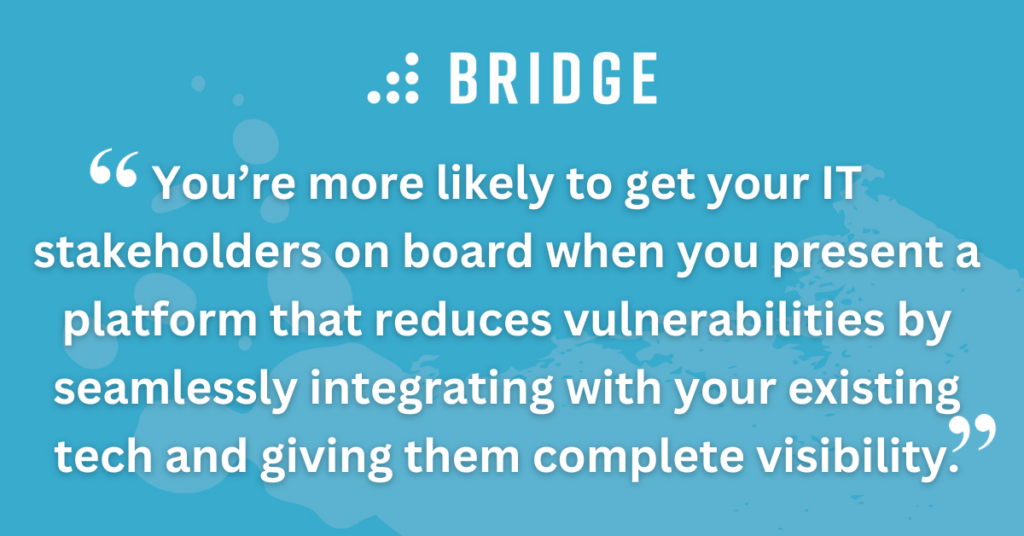
YOU MIGHT ALSO LIKE | ‘10 Facts & Stats About Learning Retention You’ll Want to Remember’
Find a Learning Platform That Works for Your Organization
SaaS management platform Zylo predicts that as of 2024, less than 20% of midmarket organizations use single sign-on apps and platforms. Without centralized visibility, findings suggest that these organizations are at greater risk of a cybersecurity incident.
Outline the potential risks and costs associated with security breaches and how the right software solution can mitigate this risk. You're more likely to get your IT stakeholders on board when you present a platform that reduces vulnerabilities by seamlessly integrating with your existing tech and giving them complete visibility.
FIND OUT MORE | ‘How to Pitch HR Tech to Your IT Team’
Review Your Tech Needs
When building your budget, consider solutions for trimming costs that also increase efficiency. For instance, if you deliver in-person or instructor-led training events to a remote or distributed workforce, you'll likely find that eLearning can reduce your costs—especially when adding up costs like hotels, airfare, and venue hire!
You should also look for ways to consolidate your existing employee development tools into an all-in-one corporate LMS.
LEARN MORE ABOUT CONSOLIDATING YOUR LEARNING TECH | ‘5 Benefits of Integrating Your LMS With Your HRIS’
See How Bridge’s Corporate LMS Can Help
Make the most of your budget with Bridge’s LMS. One platform is all you need to create, deploy, and measure impactful training that drives business performance.
